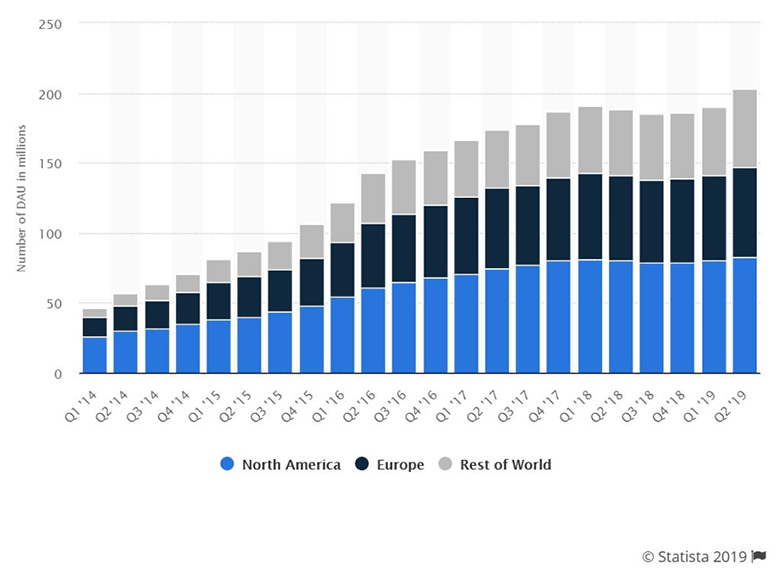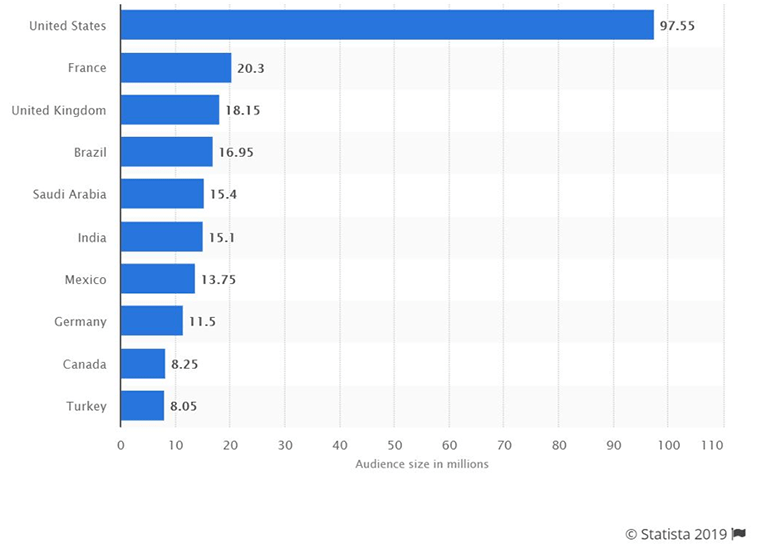Snapchat: data and demographics
In the first quarter of 2019, Snapchat daily users exceeded 203 million, and the app is particularly popular amongst so-called millennials (people born between 1981-1996) and females (61% of total users are female). As of the second quarter of 2019, Snapchat revenue is estimated at $388 million, with users being able to buy in-app features and ads that cost between $3,000 to $700,000 a day.
83 million Active Daily Users are based in North America, and 64 million are based in the EU and it was estimated that in 2019 3.5 billion snaps are sent every day. In the rest of the world, there are estimated to be 56 million users, but this figure is considered to be growing very fast, rising from 49 million users in the first half of 2019 to 56 million, in the second half of 2019.
Snapchat daily active users worldwide, Q1 2014- Q2 2019

In terms of the amount of time users devote each day to checking Snapchat, some estimates have placed this at between 27 to 50 minutes every day.
In terms of the countries where snapchat is used the most, the US is by far the biggest Snapchat market, with 98 million users. France is the second biggest Snapchat market, with 20 million users and the UK is in third place with more than 18 million users.
Snapchat users by country, July 2019

Snapchat
Snapchat was developed in 2011 out of Venice, California by Evan Speigel, Reggie Brown and Bobby Murphy. Originally branded as “Picaboo” on the iOS operating system, the concept focused on instant communication that was deleted within a short time frame, usually within 10 seconds after viewing. The app was released as an Android app in 2012. One of the founders commented that their inspiration for Snapchat’s short time frame for communication and posts came from the practice of people “cleaning” their Facebook posts history before job interviews or in light of subsequent events, to remove material that has become outdated, irrelevant or embarrassing – something that has also become known as “emergency detagging”.
Snapchat users can post stories which are deleted after 24 hours. These are known as “snaps” and they can take the form of videos or pictures. Snaps can be edited using the app, to add filters, captions, effects and drawings. Friends can be added to the Snapchat app using a “nearby” search function, or by using unique IDs known as snapcodes.
In 2013, users could create a chronological story using the “my story” feature. This allows users to arrange their stories to be viewed in a chronological line, similar to the Facebook timeline. In 2014, this feature was developed to make it collaborative, so stories could be added within a group story, which has proven especially popular for events. In 2015, this feature was further developed to allow users to post “official stories”, which was useful for public figures.
In 2014, Snapchat added video chat functionality, allowing users to communicate using video. Also added in 2014 was a money transfer functionality, which allows users to send and receive cash using the app. In 2016, an additional feature known as “memories” was added which allowed users to save stories in a private area on the app, only accessible by the user. Memories are recognisable from their white frames, and time stamps and these can be added to a secure area known as “my eyes only”, which is protected with a PIN code access feature for privacy and security.
Additional functionality developed in 2017 allowed users more control over time frames used in relation to snaps and now allows for content to be retained unless it is specifically deleted by the user. Also, in 2017, users were allowed to link snaps to external websites, a functionality that had previously been restricted to brands and businesses.
As of 2018, Snapchat users can integrate with Skype, Zoom and Twitch features, including desktop video chat functionality, through the Snapchat desktop application.
Snapchat has also evolved to integrate face detection technology and augmented reality technology, allowing users to personalise snaps and use 3D objects within their snaps.
Snapchat has various unique features including what is known as a geofilter, which allows users within a certain geographical area to add graphical overlays to their snaps. This feature has proven useful for events in specific locations. Additionally, various avatars, stickers and overlays can be used to personalise content.
Snapchat also has a unique system which creates a “hierarchy” of friends and contacts, for example users can recognise one of their contacts as a BFF (Best Friends Forever), a “bestie” or a Super BFF. A feature known as a snapstreak indicates two contacts who have messaged each other for several days in a row. Snapstreaks are only maintained between friends who message each other every day.
In 2019, Snapchat was tweaked to increase its appeal to ecommerce marketing professionals, through the launch of so-called dynamic ads. These ads allow for a marketing professional without any design skills to create and insert an ad to the Snapchat platform. Using dynamic ads, the marketer can use templates and unique design features to create high quality mobile ads, which are particularly popular in ecommerce campaigns. These features are designed to appeal to smaller businesses who don’t have in-house designers who have historically designed ads manually. In removing the need for in-house or bespoke designers, Snapchat has widened the appeal of its platform and allows businesses to save money by using the Snapchat dynamic ads service.
Other features of the new system of dynamic ads include syncing with established audiences and product catalogues. This allows advertisers to tap into established networks, using the Snapchat advertising platform, and again, this makes the service easier and more convenient for marketing professionals to use.
Snapchat and ecommerce
The sheer numbers of people using Snapchat every day has sharpened its appeal for use in ecommerce campaigns to increase brand awareness and sell products and services. As such, Snapchat is used in various ways to promote brands, products and services. Indeed, such is the power and reach of the medium that ad space can command fees amounting to millions of dollars for just one day of advertisement.
Food and travel video network business Tastemade has been using Snapchat since 2012 and has found the medium particularly useful due to its heavy reliance on video and visual content to make connections with new and existing customers. In 2012, there were limited options available for Tastemade to showcase its unique brand, but Snapchat proved to be an instant success story for the brand which made full use of the Snapchat “discover” feature to disseminate videos across multiple social media channels. As of 2019, Tastemade got more than 20 million views of its videos monthly, and videos that were posted aren’t particularly costly to create either.
Tastemade also regularly “recycles” videos that have been purpose-made for Snapchat, by tweaking them and reposting them on other social media platforms. This again, cuts down the cost of video production and allows the business to communicate with a wider audience. Tastemade has also been careful to curate videos that add value to their audiences and there is no “hard sell”; the material merely serves as an enticement for viewers to visit the Tastemade website, where customers’ personal data can be harvested for future advertising campaigns, if the customer registers. This approach allows for a high rate of conversions and sales per low-cost video. Indeed, the company’s co-founder stated that Snapchat was an integral part of the company’s global expansion and entry into several international markets including California, Tokyo and London.
Tastemade isn’t the only success story. There are thousands of similar successes, including ethical apparel brand Everlane which has mirrored the approach taken by Tastemade in that there is no hard sell approach adopted. The brand merely uses Snapchat as a way to entice new customers to visit its website and explain the underlying concepts and ideas that drive the Everlane brand. However, once traffic has been diverted to the Everlane website via Snapchat numerous sales tactics are employed to drive sales and this combination of both soft and more direct marketing tactics has proven to be very effective.
The main idea that underpins the Everlane brand is a commitment to ethically sourced apparel products with a transparent supply chain. Customers using this brand are reassured that the products sold aren’t being produced in sweatshops, are cruelty free and aren’t manufactured through the use of child labour. Many mainstream brands including Primark have faced devastating backlashes from customers when ethical scandals have been exposed in an age where the internet affords so much access to information and customers are developing higher expectations about how transparent a brand should be about its supply chain and ethics. For example, in 2014, Primark struggled to retain customers when it was disclosed that some of its products were manufactured in slave labour conditions in China. A note found inside a pair of Primark trousers read “SOS, SOS, SOS” and exposed the horrific working conditions that Primark products were created within. As a result of this and other scandals, customers are paying even more attention to how ethical the supply chain of a brand is and Everlane cleverly decided to tap into this emerging trend and in the process fulfilled a “gap in the market” – the holy grail of any up’n’coming ecommerce brand.
Casper, a modern e-commerce-focused mattress retailer has successfully used Snapchat to launch its brand and drive its sales in an already crowded and saturated market for mattress sales. It wanted to attract younger generation buyers including millennials and saw Snapchat as the right platform to use to reach this audience. Owing to the crowded market for mattress sales though, it needed to devise a novel marketing technique that enabled it to stand out from traditional mattress sellers. It achieved this through using visual marketing messages that focused on feelings as opposed to the traditional messages that mattress sellers usually convey like warmth and comfort. Instead Casper sought to evoke how a great mattress made someone feel and its campaigns have centred, for example on the experience of lying in bed after a long day at work, the feeling of being curled up in pjs and the experience of watching television in bed. It was hoped that this emphasis would also allow for customers to associate positive emotions with its brand, for example playfulness and youthfulness.
Positive associations have also been used by Casper in conjunction with the idea of adding value for free to its audience, and this has proven to be a hit with its Snapchat following. For example, Casper has devised an entertainment series, focused on relaxation, known as Waffle Brunch Wednesdays, where viewers are encouraged to tune into a regular time slot in order to catch up with its recurring segment. The segment advertises mattresses without any hard sell and viewers who don’t make any purchases still get valuable tips and ideas from the content. Casper has always seen the benefit in a constant, steady stream of advertising and it is known for running its regular entertainment segment, as well as posting a new snap every day.
Another so-called Snapchat success story is a company called Birchbox, which specialises in sending samples of cosmetics to subscribers. The unique selling point of the business is the idea that trialling cosmetics products can help you save cash. Birchbox has been unique in its approach to engaging with its audience and relies heavily on evaluation strategies to decide the best way to appeal to its audience, for example it ran a Black Friday campaign which was designed to gain customer feedback and insights into customer preferences. As a result, it devised a highly successful campaign centred on exclusive deals and promotions aimed at making customers feel valued and special.
Birchbox’s unique Snapchat url on Snapchat which enables the brand to track how its users have responded and engaged with its marketing campaigns has also augmented its approach, and the result has been burgeoning sales and conversions from a highly successful ecommerce Snapchat campaign.
Mobile-focused Grubhub, a food delivery company, has gained considerable market share due to its highly successful Snapchat campaigns involving apps. Its strategy was simply to identify where the mainstay of its target market regularly “hangs out” and target messages within this area. This focus enabled Grubhub to focus all of its resources within an area where it knew there would be a high uptake of its message, rather than spread its resources more “thinly” over an array of platforms and mediums.
The Grubhub communications strategy is, like many successful Snapchat based ecommerce strategies, novel and tailored to the brand. It involves encouraging new users to engage with the content it disseminates and develop a relationship and rapport with the brand and its messages. Competitions are a particularly popular engagement strategy used by Grubhub, as these encourage long-term relationships with customers, build trust and enable data to be stockpiled for future use.
Other uses and applications of Snapchat within ecommerce
Successful ecommerce campaigns have also taken the form of contests and product giveaways that are exclusive to Snapchat users, for example some brands have held contests to name a new product or collection of products.
Making sneak peeks of forthcoming products and services available on Snapchat has also proven to be a failsafe marketing tactic. People are very attentive to their favourite brands and supplying teasers and exclusive access to view new products and services is a great way to capture people’s attention and get them habitually returning to a brand website for new updates. Snapchat can also be used to notify people of new products and the release dates of new collections, for example hotly anticipated gadgets, and the “story” format allows for teasers to be provided in a range of mediums including short videos and images. These continue to be powerful ways to communicate brand and marketing messages to the general public.
Furthermore, the format used within the Snapchat platform which takes the form of stories as opposed to “feeds” prevalent in other forms of social media such as Facebook, is reported to be growing in popularity. Some estimates have suggested that stories are shared up to 15 times more than feeds, at this rate of growth is gathering pace.
Snapchat: increasingly the medium of choice for savvy ecommerce marketers
More popular in North America, but steadily gaining ground and influence in Europe and the rest of the world, Snapchat is becoming the platform of choice for many ecommerce savvy retailers wishing to kickstart their marketing campaigns by appealing to a younger generation of customers and followers. However, Snapchat is a unique medium, so sellers really need to tailor a campaign to the audience being targeted. Provided this is done with reasonable precision, Snapchat is a safe bet for ecommerce-focused sellers looking to expand an existing customer base, or promote a fresh new concept, product or idea.
